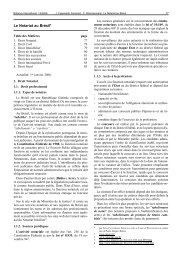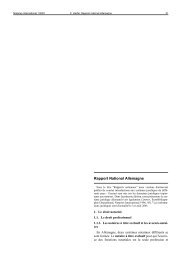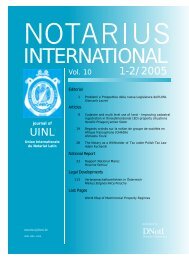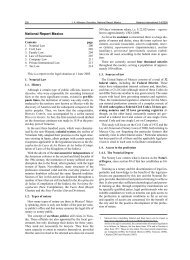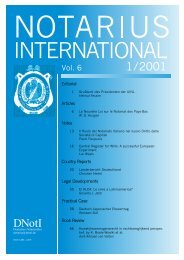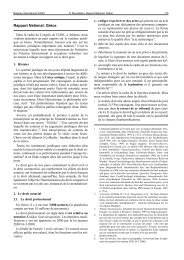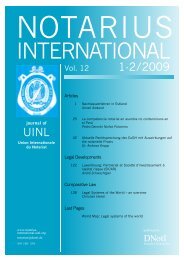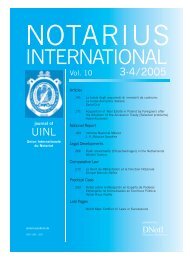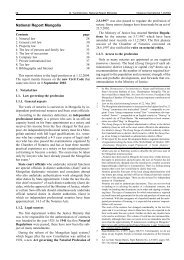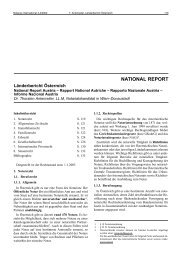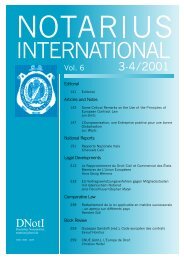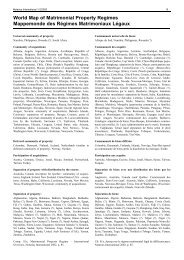ARTICLES and NOTES - Notarius International
ARTICLES and NOTES - Notarius International
ARTICLES and NOTES - Notarius International
Create successful ePaper yourself
Turn your PDF publications into a flip-book with our unique Google optimized e-Paper software.
240 O. Soergel/O. Stöcker, EU Enlargement <strong>and</strong> Property Law <strong>Notarius</strong> <strong>International</strong> 3-4/2002<br />
Diagram 7: L<strong>and</strong> Charge (Grundschuld)<br />
same time however the security contract between the<br />
(third-party) provider of the security <strong>and</strong> the lender taking<br />
the security creates the causa as between these parties<br />
that entitles the lender to keep the security.<br />
Diagram 8: double causation, if security is furnished<br />
by a third party<br />
Although in practice the powers <strong>and</strong> obligations of the<br />
creditor of the l<strong>and</strong> charge in respect of the l<strong>and</strong> charge<br />
(Grundschuld) are generally governed by a special contract<br />
between the provider of the security <strong>and</strong> the taker of<br />
the security, the so-called security contract or security<br />
agreement (Sicherungsvertrag) , this does not alter the<br />
non-accessory nature of the l<strong>and</strong> charge. This so-called<br />
security contract has, amongst others, the following functions<br />
in particular in this context:<br />
It describes the security purpose (Sicherungszweck).<br />
Thus it establishes, in relation to the contract partners, the<br />
purposes for which (i.e. for the security of which claims<br />
by the taker of the security or by other creditors) the taker<br />
of the security may use the security. As a result it takes<br />
on a similar function in the property law context to the<br />
role played by the statutory rules on accessoriness in the<br />
case of accessory securities.<br />
In addition, according to a widely held view 6 , it also<br />
contains the causa for the provision of the security. If the<br />
security contract is defined in this way then it contains<br />
the obligation of the provider of the security to give the<br />
agreed security to the taker of the security. If one looks at<br />
the contractual practice of the German banks however,<br />
then such a definition of the security contract is unclear<br />
to say the least, as normally the loan contract itself already<br />
contains the provision that the making of the loan<br />
is dependent upon the provision of a specified security. In<br />
this report therefore the authors start from the assumption<br />
(2.2 above <strong>and</strong> 3.1, 3.2 below) that the causa for the<br />
provision of the security is contained in the loan contract<br />
<strong>and</strong> not in the security contract. At the end of the<br />
day the difference between these two points of view does<br />
not matter – at least where the provider of the security<br />
<strong>and</strong> the borrower are one <strong>and</strong> the same person; the crucial<br />
thing is that the obligation to provide the security is governed<br />
somewhere in the contractual arrangements between<br />
the borrower <strong>and</strong> the lender.<br />
In the case where the borrower <strong>and</strong> the provider of the<br />
security are not one <strong>and</strong> the same person it is however<br />
clear that in the borrower/lender relationship it is not the<br />
security contract to be entered into between the (thirdparty)<br />
provider of the security <strong>and</strong> the lender taking the<br />
security that is the causa for the provision of the security<br />
but the loan contract, in which the borrower assumed an<br />
obligation to provide the security to the lender. At the<br />
Unlike the case with accessory security interests therefore,<br />
the provisions contained in the security contract only<br />
create rights <strong>and</strong> obligations; they do not change the legal<br />
attribution of the security in any way.<br />
Diagram 9: Accessoriness (Akzessorietät)<br />
2.5 Accessoriness in Europe<br />
2.5.1. The different legal systems<br />
If one looks beyond the German legal system then one<br />
finds a large variety of different types of property charges<br />
elsewhere in Europe in which accessoriness is more or<br />
less pronounced depending on the legal system. Very few<br />
legal systems have two such differently structured charges<br />
over property as German law with its Hypothek<br />
(mortgage) <strong>and</strong> Grundschuld (l<strong>and</strong> charge). The two<br />
poles of the European spectrum, from “closely accessory”<br />
to “non-accessory” are represented on the one side by<br />
France with its mortgage which is closely accessory to<br />
existence <strong>and</strong> on the other side by Germany with the nonaccessory<br />
Grundschuld (l<strong>and</strong> charge).<br />
6 Cf amongst others MünchKomm-Eickmann, BGB, 3rd Edition 1997,<br />
§ 1191 Rz. 13; Soergel/Konzen, BGB, 13th Edition 2001, § 1191 Rz.<br />
12; Staudinger/Wolfsteiner, BGB, 13. Edition 1996, Preliminary<br />
statements to §§ 1191 onwards Rz. 23.



